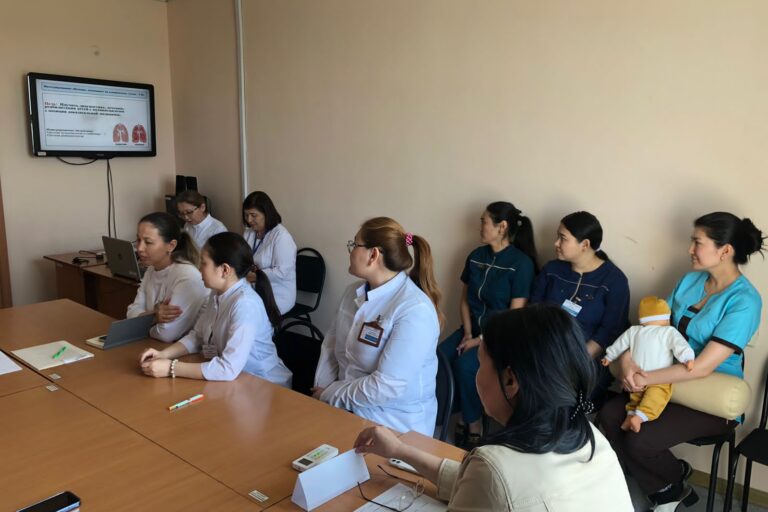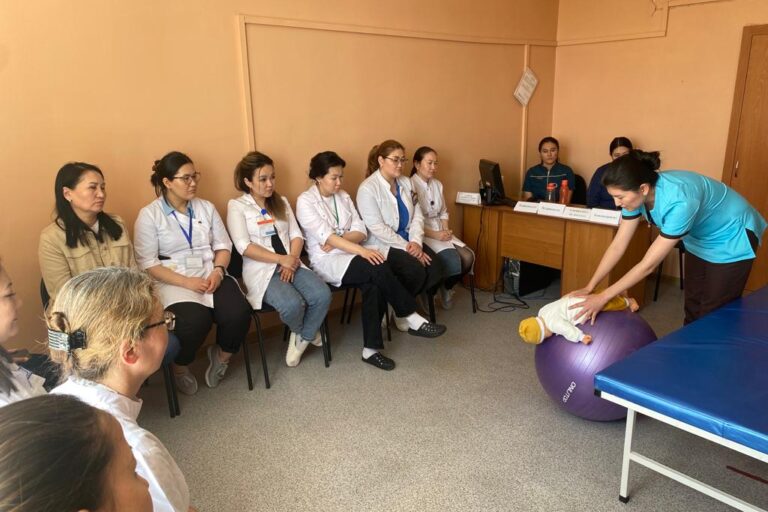Integration in learning, focused on the final result, allows us to overcome the existing today, the subject disunity, which is one of the reasons for the fragmentation of the worldview of a university graduate. The form of the integrated lesson is non-standard, interesting and can be applied in combination and combinations with other innovative teaching methods, which makes it possible to increase the effectiveness of classes.
According to the plan of open classes of the university for the 2022-2023 academic year, on June 02, 2023, teachers of the Department of Pediatrics and Medical Rehabilitation named after Tusupova D.M. Alimbayeva A.R. and Imanmadiyeva D.M. conducted a lesson with resident pulmonologists for 2 years of study on the topic “Cystic fibrosis in children: the current state of the issue”. Lesson format: Integrated learning based on a clinical case – CBL. To assess the quality of the lesson, the head teacher of the Department of Radiology Kuanysheva A.G.; Candidate of Medical Sciences, Assistant of the Department of Emergency Medicine named after Professor corresponding member of the National Academy of Sciences of the Republic of Kazakhstan Dyusupova A.Z. Baibusinova Zh.T. visited the lesson.
Cystic fibrosis in Kazakhstan can be attributed to widespread hereditary diseases. Only in Semey, according to data for 2022, there were 10 children with cystic fibrosis. CBL, which was based on a real case transferred from the status of “the life situation of patient A. with mixed form of cystic fibrosis complicated by cirrhosis of the liver with portal hypertension” to the status of the task, was developed by Assistant of the Department Imanmadiyeva D.M. for this lesson in accordance with the methodological requirements. 2 disciplines are integrated: pediatric pulmonology in hospital – 2 and pediatric rehabilitation. To answer the questions posed by CBL, high-quality independent work of residents was required. To prepare residents on the topic of the lesson, a Google drive was created in advance. It included national and international clinical protocols and recommendations for the diagnosis and treatment of cystic fibrosis in children, some articles and publications of evidence bases – Cochrane and UpToDate. As part of the analysis of the topic, 7 reports were heard in the form of presentations (independent work of a resident) on modern methods of diagnosis and treatment of cystic fibrosis in children, 2 videos (independent work of a resident) were shown, filmed by residents using the method of peakflowmetry and spirography.
On issues of diet therapy, drainage of the bronchial tree in the conditions of the ICU and pediatric department, physical therapy, rehabilitation of a patient with cystic fibrosis after discharge from the hospital using the “equal to equal” method, resident pulmonologists were trained by resident rehabilitologists for 2 years of training under the guidance of the head of the department Alimbayeva A.R. For each of the above CBL issues, resident rehabilitologists prepared presentation messages with a demonstration of drainage positions and exercise therapy exercises in practice, on simulators.
As a result of the discussion of CBL issues, a set of measures for the diagnosis, treatment and rehabilitation of patient A. with cystic fibrosis was developed.
During the discussion of the topic, residents showed high activity, good knowledge of etiopathogenesis, diagnosis, differential diagnosis, treatment of cystic fibrosis in children.
The lesson ended with the writing of the final test control (10 tests, 3 of them on the rehabilitation of children with cystic fibrosis).
Evaluation criteria for resident pulmonologists on the topic of the lesson were:
- Participation in the analysis of a clinical case (answers to CBL questions) – 60% of the total score for the analysis of the topic.
- Presentation (independent work of a resident) – 20%.
- Video on practical skill (independent work of a resident) – 10%.
- Final test control – 10%.
The feedback received from the students demonstrated a good level of assimilation of the educational material and an understanding of the need for an integrated approach to ensure the quality of life of children with cystic fibrosis and prolong their lives.
A positive assessment was received from the members of the commission on the methodology of the lesson.
Integrated training based on a clinical case – CBL allows you to form a comprehensive vision of a problem, situation by combining knowledge and skills in individual disciplines into a single whole, based on their interdependence and complementarity.[/vc_column_text]
[/vc_column][/vc_row]


